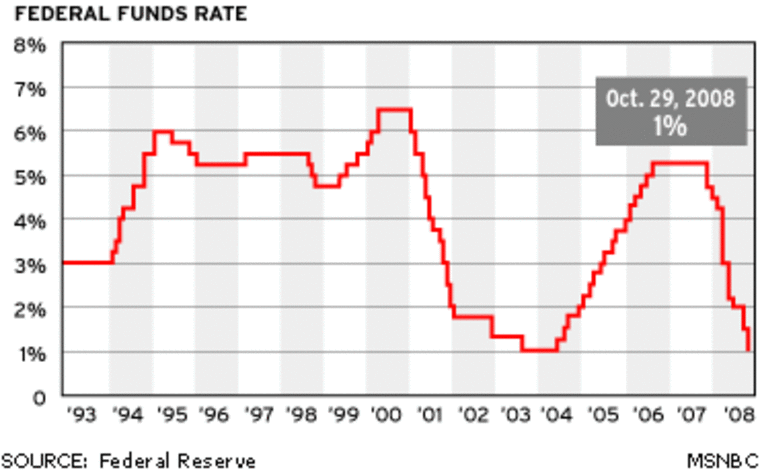The Federal Reserve's interest rate-setting committee announced Wednesday that it was lowering its target overnight rate by a half-percentage point to just 1 percent.
But as central bankers continue to wield a wide variety of monetary tools these days, the rate cut might not make all that much difference. For now, the rate-setting policy that has historically been one of the Federal Reserve’s bluntest and most powerful instruments looks more like a paring knife.
Since the credit crisis took hold of financial markets last month, the Fed has tried almost everything, including paying hundreds of billions for mortgage-related investments, commercial paper and other assets no one else wants.
The latest cut in the overnight lending rate for banks is almost ceremonial. While it might help boost morale a bit, some analysts suggest the Fed should stay on the sidelines and retain the ability to cut rates in the future if needed.
“It doesn't matter what the Fed does,” said Rich Berg, chief executive officer of Performance Trust Capital Partners, a Chicago-based bond trading firm. “The market rates are going to be the market rates. Why waste the bullet now? Why not save those bullets?”
But others say the largely symbolic move is still important.
“The sentiment of investors, of consumers and everybody that's involved in this country is at a low,” said Peter Costa, a stock trader at Eckhart & Co. “We all know that it's not going to make any difference in the credit markets. But it is going to be something that's going to be significant that the government is still being proactive.”
The widely expected cut in the so-called federal funds target will have little impact on the actual short-term cost of borrowing by banks, though some businesses and consumers may catch a slight break if they borrow at variable rates tied to the target.
In normal times, the Fed manages the interbank lending rate through the purchase and sale of Treasury securities to add or drain cash to the banking system. But with the financial storm raging, the Fed has had mixed success keeping monetary policy on course and hitting that target rate. As a result, financial markets already have cut short-term rates for the Fed.
“They could go more, because the actual fed funds rate is already much lower than the targeted fed funds rate,” said former Fed Gov. Robert Heller.
Cutting the fed funds rate to 1 percent matches the lowest level reached during the housing boom and naturally raises concerns that the Fed may be repeating a mistake that led the way to the current crisis.
But few seem worried about that threat because economic and market conditions are very different, according to former Fed Gov. Wayne Angell.
“I don't think this will be the mistake that it was in 2003,” he said. “Because this time we have deflation in housing, and we have a serious commodity price deflation that says to them, ‘You’d better get with it.’”
Those deflationary pressures may give the Fed breathing room to cut rates further. But cutting the target rate won’t address one of the most troubling dangers the economy now faces: the sharp pullback in consumer confidence and spending.
On Tuesday, the Conference Board reported that its widely watched consumer confidence index fell to 38, its lowest level since the index was introduced in 1967. The level was down from a 61.4 in September and 95.2 a year ago.
“(The) shockingly weak reading on confidence no doubt reflects the fears of a financial and equity market meltdown,” said John Ryding, chief economist at RDQ Economics, in a note to clients.
Consumers also are spending less because they have less to spend. Rising unemployment means households have less purchasing power. Falling home prices have wiped out much of the equity consumers had been tapping during the boom.
And there are few signs of a bottom in home prices. One closely watched index released Tuesday showed that urban home prices tumbled nearly 17 percent in August from year-ago levels.
Earlier this month, the Fed cut its target rate by a half-point in a coordinated move with central bankers around the world. European Central Bank President Jean-Claude Trichet said Monday a rate cut next month is "a possibility" now that the price of oil and other commodities have fallen.
But rate cuts might not be enough to head off a downturn in Europe as a housing slump and the widening financial crisis weighs on economic growth there. As the advanced economies of the developed world grind to a halt, much depends on the emerging economies of Asia and Latin America — where U.S. central bankers have no control over monetary policies.
At a securities industry conference in New York Tuesday, John Lipsky, a senior official at the International Monetary Fund, said the IMF is forecasting that next year "100 percent of global growth is going to come from emerging economies."
Lipsky said the IMF has $200 billion in reserves to help try to head off the economic downturn in those economies. But it’s far from clear that will be enough, he said.
“The virulence with which the emerging market economies have been hit first by the financial turmoil and secondly by the threat of a significant slowdown in the advanced economies has been striking,” he said. “It's happened so quickly. Happily we're in a position to respond quickly, but we can't take for granted that we're anywhere near an end."
